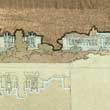News archive
A circus opera The Carnival
17 and 18 February 2017
The Concourse, Chatswood, Sydney, Australia
Special performances of The Carnival will raise money for the Haven Amphitheatre reconstruction project.
Described as "circus opera" The Carnival debuted on London's West End in 2011 and is composed by very talented Castlecrag-born Chloe Charody.
Another of Chloe's operas is currently on tour in Europe where she is rapidly becoming a leading female composer.
Soprano Valda Wilson will be The Carnival's leading lady. Valda, also Castlecrag-born, won Opera Foundation Australia's scholarship to train at the National Opera Studio, London. She has been a principal soprano at the Oldenburg State Theatre, Germany since 2014 and in December 2016 sang the title role in Handel's Theodora for Pinchgut Opera in Sydney.
The Carnival will be an amazing performance, and you are encouraged to purchase tickets so as not to miss this fabulous and innovative circus opera and to help fundraising for the Haven Amphitheatre reconstruction project.
The performances are being organised by Haven Promotions Inc. Book now:
www.havenpromotions.com
Box office (02) 8075 8111
www.theconcourse.com.au
Ticketek 1300 795 012

In Her Own Right: Marion Mahony Griffin
7 October 2016 – 12 March 2017
Elmhurst History Museum, 120 E. Park Ave. Elmhurst, USA
Marion Mahony Griffin’s story is now being brought to light with a new exhibition presented by the Elmhurst History Museum entitled In Her Own Right: Marion Mahony Griffin. The exhibition brings Mahony Griffin’s own story out of the shadows as a brilliant architect, talented artist, avid environmentalist, and social activist. In Her Own Right traces Mahony Griffin’s early life, her personal and professional partnership with her husband on three continents, her final years in Chicago where she died in obscurity and penniless, and considers the legacy of a Chicagoan of immense but often overlooked importance, shedding light on the unheralded Prairie School innovator and Illinois’ first woman architect
The Griffins are perhaps better known in Australia than they are in the U.S. due to the years they spent there working on the elaborate Plan for Canberra, an impressive international contest-winning design created for the country’s capital city, and the suburb of Castlecrag, an idyllic community in Sydney that assimilated architecture into the natural landscape. So it is fitting that the Elmhurst History Museum turned to Dr. Anna Rubbo, PhD, an Australian and an adjunct senior scholar at the Center for Sustainable Urban Development at Columbia University and a former Associate Professor of Architecture, Design and Planning at the University of Sydney, for development of the exhibition content.
Lance Tawzer, Elmhurst History Museum’s curator of exhibits, shared his rationale for telling Marion’s story now explaining that “Anna Rubbo brings a special perspective to this story as a scholar, an architect and an Australian”.
Opening hours: Sunday, Tuesday through Friday from 1 to 5 p.m. and Saturday, 10 a.m. to 5 p.m.
For information about exhibit-related programs with visiting scholars, authors and interesting tours visit: www.elmhursthistory.org

Marion Mahony, Elmhurst History Museum website
Pholiota Unlocked
7 October to 23 October 2016
(see website below for times)
Melbourne School of Design, University of Melbourne
This amazing project by the Melbourne School of Design's Master of Architecture students led by Philip Goad at the University of Melbourne, is open until 23 October 2016. The students have manufactured over 2300 full-size Knitlock tiles in plaster of paris for this 1:1 reconstruction of the Griffins’ own tiny Eaglemont home.
https://www.festival.melbourne/2016/events/pholiota-unlocked/#.V9FbJyN97ax
View video clips (one in fast motion) of the students assembling the tiles to build the replica https://www.youtube.com/watch?v=tlSo-qW0QDw
The Pholiota Unlocked exhibition is on the ground floor (actually down steps to a lower level) of the Melbourne School of Design, located a few buildings away from Newman College. FREE exhibition.

‘Pholiota’, the Griffins own house, Heidelberg, Victoria. Photograph c 1925 – 1930. Eric Milton Nicholls Collection. National Library of Australia.
Ethereal Eye
15 and 16 October 2016
(see website below for times)
Newman College Dining Hall, University of Melbourne
Jonathan Mills’ musical homage to the Griffins to be performed in their Newman College Dining Hall along with stunning projections onto the hall’s magnificent domed interior. Projection artist Ian de Gruchy, plus dancing by Leigh Warren and Delia Silvan. Tickets are $28 and can be booked at https://www.festival.melbourne/2016/events/ethereal-eye/#.V_t7tiN97aw
Inside the Ethereal Eye
14, 15,16, 21, 22, 23 October 2016
(see website below for times)
The Arts West Atrium, Professors Walk, University of Melbourne
Immersive projections exploring Newman College Dining Hall and the ceiling of the Capitol Theatre on an ultra-high-resolution 6 metre wide projection dome, by two of the world's leading new-media artists, Sarah Kenderdine and Jeffrey Shaw in collaboration with the University of Melbourne's Transformative Technologies Research Unit. FREE exhibition.
https://www.festival.melbourne/2016/events/inside-the-ethereal-eye/#.V_uFACN97aw

Image: Sarah Kenderdine. Melbourne Festival 2016 website.
Griffin Houses Open Day
Saturday 17 September
from 10am – 3pm
Castlecrag
With the assistance of a Willoughby City Council grant the Walter Burley Griffin Society is organising an open day of four Griffin houses with guided walks going between the houses. This is a rare opportunity to see the interior design features of some of the Griffin houses at Castlecrag built in the 1920s and early 30s.
Bookings essential – see the “Events” webpage for further information.
Tickets: www.trybooking.com/212476

Griffin Talks
Saturday 17 September at 4pm
Marion Mahony Griffin Hall, Castlecrag
With the assistance of a Willoughby City Council grant the Walter Burley Griffin Society has organised two illustrated talks in the nearby Marion Mahony Griffin Hall. The first talk The Melson House Revealed: An Owner’s Perspective will be given by visiting American art historian and author Peggy Bang, from Mason City, who is owner of the Melson house.
This will be followed by a talk about Marion Mahony Griffin by senior journalist Glenda Korporaal author of the recently published book titled Making Magic: the Marion Mahony Griffin Story.
Bookings essential – see the “Events” webpage for further information.
Tickets: www.trybooking.com/212489
National Trust Heritage Award for Visionaries in Suburbia
The Society’s book Visionaries in Suburbia: Griffin Houses in the Sydney Landscape has been awarded the winner of the National Trust Heritage Awards 2016 in the Heritage Publications category.
The 22nd Annual National Trust Heritage Awards took place on Friday 6 May 2016 at the Heritage listed, Doltone House, Jones Bay Wharf, Pyrmont, Sydney. This prestigious event which is highly regarded in the industry, had Quentin Dempster as the Master of Ceremonies, and the Minister of Environment and Heritage, Hon. Mark Speakman as the keynote speaker. The event is the highlight of the National Trust Heritage Festival and was attended by 400 guests including Jack Mundey, and the Society’s Patron John McInerney, President Akky van Ogtrop, Vice President Michael Thomson, and the book’s editor and contributing author Dr Anne Watson.
In announcing the award the National Trust’s President Dr Clive Lucas OBE stated that “This is a beautifully presented book about 22 Sydney houses designed by Marion Mahony and Walter Burley Griffin in the ‘20s and ‘30s with significant research of some of the lesser known Griffin houses. This book makes a substantial contribution to understanding the legacy of this amazing couple and is a visual feast”.
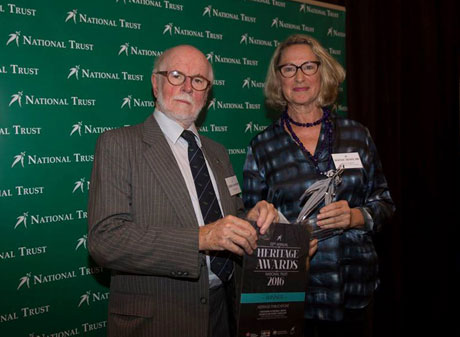
Dr Anne Watson, the book’s editor and contributing author accepts the Heritage Award from
the President of the National Trust Dr Clive Lucas OBE. Photographer Jonathon May
New Book: Visionaries in Suburbia: Griffin Houses in the Sydney Landscape published by the Walter Burley Griffin Society Inc.
September 2015
From Castlecrag to Clifton Gardens, Pymble to Avalon, Visionaries in Suburbia presents for the first time the entire range of Walter Burley Griffin and Marion Mahony Griffin’s Sydney residential designs in the 1920s and 30s. Richly illustrated and with essays by heritage specialists and Griffin home owners, the book reveals new research on some of the lesser-known houses, such as the Pratten and van der Ley residences and a range of unbuilt projects, as well as fresh perspectives on the Castlecrag estate and its unique planning and community concepts.
Not just an architectural survey, Visionaries also explores the Griffins’ holistic vision – the environmental, social and spiritual ideals underpinning their integrated design and landscape philosophy. The book concludes with a chapter on the Griffins’ legacy, the heritage significance of their houses and the relevance of their ideologies today.
Visionaries in Suburbia is illustrated with 270 colour and black and white images – many full-page – including photographs by Max Dupain, Mati Maldre and Eric Sierins, as well as Griffin office drawings and photographs from the Eric Nicholls collection in the National Library and Marion’s incomparable presentation renderings. Contributing an exciting new dimension to our understanding of the Griffins’ milieu are more than 40 previously unpublished photographs of life in Castlecrag from the recently discovered archive of Hermann Junge, a representative for Leica Cameras and a Castlecrag resident in the late 1920s and early 30s.
Coordinating Editors: Dr Anne Watson and Adrienne Kabos
Price: $59.95 available in good bookstores and online at:
http://www.manic.com.au/Visionaries-in-Suburbia-Griffin-Houses-in-the-Sydney-Landscape.html

to top
Canberra’s light rail
Capital Metro: Slow Tram Coming
11 September 2015
The three trains that run to and from Sydney each day are the only rail services that operate in our nation’s capital. However, 100 years ago, rail was the lifeblood of the infant city of Canberra, delivering the coal that generated its electricity, the bricks produced in its kilns, and the other materials needed at its major building sites.
The bold plan for the city penned by Walter Burley Griffin and illustrated by Marion Mahony Griffin envisaged trams, or ‘street cars’ as they called them, as the means of connecting the residents with their places of employment and recreation. Sadly, only one rail line survived the city’s first two decades of federal administration; the remainder having fallen victim to bureaucratic short sightedness and natural disaster. Today, a locally elected government believes the time has come to resurrect this rail heritage and bring to the city the vibrancy intended by the Griffins.
In September 2014, the Deputy Chief Minister of the Australian Capital Territory (ACT), Simon Corbell announced his approval of the business case for Capital Metro Stage 1, a 12-kilometre light rail service connecting Canberra’s city centre with Gungahlin, Australia’s fastest growing urban area. But as selection of a contractor draws ever nearer, there are still those who criticise the need for the project. At an estimated cost of $783 million, Capital Metro is the largest infrastructure project ever attempted in the ACT.
The Griffins proposed that trams would run along the city’s main avenues and that stations on the Sydney to Melbourne line would be located in the city centre and at the market complex in Russell. In 2004, the National Capital Authority reported in The Griffin Legacy that, “The Griffins’ aim was that 90% of the population would live within a five minute walk of a tram line.”
Any prospects of reviving rail in Canberra were finally thwarted between 1950 and 1953, when the city’s chief planner, Trevor Gibson reduced the width of the main avenues from 300 to 100 feet, making a future tram network unlikely.
Plans for the city’s tram network and the train line to Melbourne were never reinstated, despite a Senate Select Committee concluding in 1954 that, “the more one studies Griffin’s plan and explanatory statements, the more obvious it is that departures from his main principles should not be lightly countenanced.” However, after Walter’s direct participation in the development of the city ceased, a succession of planning bodies replaced the Griffins’ high-density subdivisions with a sprawling cluster of six towns spread over a length of 40 kilometres and separated by the wide green belts of the Canberra Nature Park.
ACT Division members of the Walter Burley Griffin Society accept the need for the Capital Metro Light Rail project, not least because, in essence and as a tentative start, it revives the Griffins’ vision for the nation’s capital. The prospective changes in urban form, infrastructure efficiency and creative long run sustainability in economic, social and environmental terms reflect Griffin’s basic principles of an integrated transport system and organic city development, incorporating a range of potential benefits nowadays encompassed by sustainability.
However, members have significant reservations about the route alignment, location of stations, making of place reservations and the lack of a metropolitan-wide plan. Several of us have conveyed a number of questions and ideas to the Metro Project Team and participated in reference group urban design workshops on Northbourne Avenue and City stations. Luke Wensing has been appointed by Capital Metro to the Public Transport and Engagement Advisory Panel, which reviews the Community Reference Groups.
There have been notable proposals for trams in Canberra. In the 1980s, the Canberra Tradesman’s Union Club planned to fund a tram route through the city centre to promote tourism. In 1992 development company Canberra Land offered to build a light rail line in exchange for land on almost the same alignment being proposed for Capital Metro.
In 1997 the Conservation Council for the South East Region and Canberra, supported by funding from the Canberra Business Council and expert advice from Peter Newman and Paul Mees, issued a comprehensive transport strategy, including light rail under the title Canberra at the Crossroads: a way out of the transport mess. In 1998, the firm Bishop Austrans proposed a light rail service between the airport and the city centre. Neither Liberal nor Labor ACT Governments responded to these initiatives.
In a media statement on 14 August 2015 announcing that he would not be seeking re-election in 2016, Minister Corbell said that during his final fourteen months in office he would “particularly look forward to seeing the first stage of a Canberra-wide light rail network begin construction next year.” He is resolutely supported by Chief Minister Barr notwithstanding major budget issues.
Capital Metro is developing a Light Rail Master Plan for the Gungahlin-Civic stage to integrate all forms of transport. The planning is currently extended to a link from the City along Constitution Avenue to the Defence precinct of Russell, attracting strong support from business and community groups. This latter scenario affords Canberra a main chance to create a station with mixed land use activities at this node of the National Triangle.
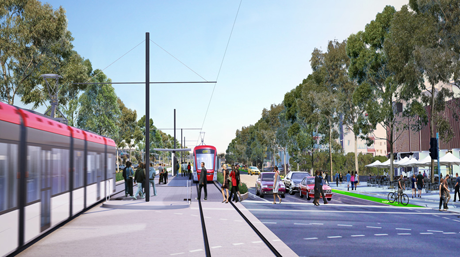
ABOVE: Image reproduced from inthecitycanberra.com.au/capital-metro-update/
(2 September 2015)
The ACT Shadow Transport Minister, Liberal MLA Alistair Coe questions the very need for Capital Metro saying that, “Canberra does not need light rail. The government knows that realigning bus services could achieve the same result at a fraction of the cost.” This will be the case that the Liberals will be taking to ACT residents before the 15 October 2016 election.
The federal Assistant Infrastructure Minister Jamie Briggs warned Mr Coe not to cancel contracts after the 2016 ACT election, labelling the move “economic lunacy.” More recently, Prime Minister Tony Abbott pointed to Capital Metro as an example of how such projects should be funded.
It would appear that after a century of frustration and inaction that, notwithstanding the lack of a metropolitan-wide plan, the Griffins’ vision for rail transport in our nation’s capital might finally be a step closer to reality. Although not everyone agrees that Capital Metro can deliver the promised benefits, it is a chance to revive the challenge and excitement of the planned ‘ideal city.’
From a paper by Joseph Biggerstaff
edited by Brett Odgers in discussion with Rosemarie Willett, Ann and Bruce Kent and Luke Wensing
Haven Amphitheatre update
March 2015
Marion Mahony Griffin was the driving force behind the establishment in the early 1930s of the Haven Valley Scenic Theatre, an open-air theatre for the community created in the natural glen at Castlecrag beside the foreshore reserve and the waters of Middle Harbour, Sydney. Local sculptor and stonemason Bim Hilder, along with the Griffins and other members of the community, built the amphitheatre by creating seating out of sandstone blocks on the western side of the glen.
As Marion Mahony Griffin describes in her memoir The Magic of America:
“No man-made imitation of indoor theatre here but every fairy creation carefully, religiously safeguarded; wattles, different kinds, so golden blossoms for each month in the year. …
“The rest of the valley is the stage, trees and bush and blossoms and rocks to meet any dramatic requirement. To the North a steep rock wall with a long terrace - a road in fact above the eye running East and West. Above it terrace on terrace of spectacular rocks and shrubbery and grand trees. To the East a flat terrace above the eye so scenes can appear and disappear across it, mysterious or spectacular. Then the little stream flowing down to the sea, its head and its further bank offering a rich range of settings - terraces, huge boulders, exquisite varied shrubbery - dainty Lily of the Valley trees and majestic Angophoras …” (page 430)
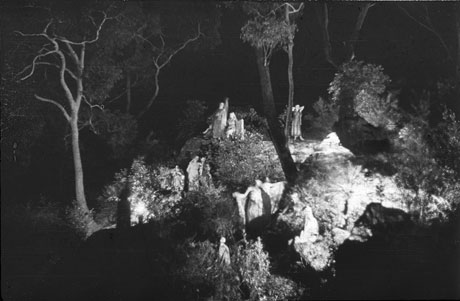
ABOVE: Performances in the 1930s at the open-air Haven Scenic Theatre in Castlecrag utilised the amphitheatre’s natural rocky terrain for dramatic effect. Nicholls Collection, National Library of Australia. nla.pic-vn3961885.
Following Walter Burley Griffin’s death in 1937, Marion Mahony Griffin’s return to Chicago in 1938 and then World War II (with the requirement for complete blackout at night) performances ceased.
In 1943, three reserves including the amphitheatre were given to Council by Marion Mahony Griffin in trust for the community.
In 1976 the amphitheatre was resurrected by the community and a timber stage, designed by local architect Robert Sheldon ‘that touches the earth lightly’, was built by the community. The design received a Royal Australian Institute of Architect NSW Chapter Commendation Award in 1977. The timber stage was extended in 1992, again to a design by Robert Sheldon.
In 2012, the Haven Amphitheatre Committee prepared a concept that proposed building a new stage in concrete. Concerned about this, the Walter Burley Griffin Society sent a detailed illustrated letter to the Haven Amphitheatre Committee and Willoughby City Council.
In 2014 Willoughby City Council commissioned an independent report on the timber stage which revealed that the existing timber structure is generally in a sound condition but that the structural members of the stage are undersized and need strengthening/rebuilding to achieve Australian Standards load rating for the stage capacity. Despite the favourable report by structural engineers, it was decided to close the stage and prepare new design options for stage improvements.
The Council published these reports on its website and called for comments. Attached is the Walter Burley Griffin Society’s letter dated 7 March 2014 to the Council.
The Council organised a site meeting and the Walter Burley Griffin Society documented its concerns and important aspects of the Deed in a letter to the Councillors dated 23 July 2014.
During 2014, the local community groups–the Castlecrag Progress Association, Castlecrag Conservation Society, the Walter Burley Griffin Society and the Willoughby Environment Protection Society–prepared a joint perspective of the elements they wished to see incorporated into any new stage design. Willoughby City Council called for nominations to a community consultative group that will meet three times during the design preparation process. Experienced planner and Griffin Society committee member Margaret Petrykowski represents the Society on this group. In mid-February 2015, Council appointed Craig Burton from CAB Consulting to prepare design options for the stage improvements. Members of the community consultative group will provide local insight and knowledge into the design preparation process.
It is the unconventionality of the Haven Amphitheatre that makes it so special. Its uniqueness, irregularities, idiosyncrasies and natural bushland beauty need to be preserved and not damaged in any way. There is no other amphitheatre like it in the world.
Any proposal for redeveloping the Haven Amphitheatre needs to completely respect the natural landforms, rocks, creek, trees and bushland of the site, and ensure they are not damaged in any way. In 100 years time when any new structure has decayed, it should be able to be removed leaving the glen uncompromised in its natural splendour.
The Haven Amphitheatre is a community resource that should remain understated, in keeping with the original aims of the Griffins.
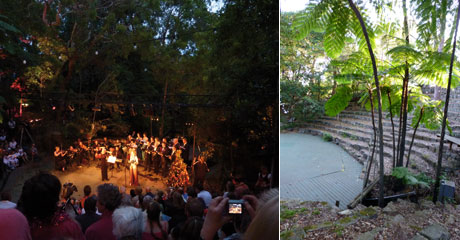
ABOVE: At left Carols by Candlelight on Christmas Eve, 2009. At right tree ferns growing at the creek and the original stone seating beyond, 2013.
Proposed new planning laws threaten heritage and conservation areas
Among the aims of our Society is promoting the preservation and conservation of landscape designs, buildings and other works designed by or having an association with the Griffins. Thus the Society is active in many spheres of environmental and heritage conservation throughout Australia, and we maintain a keen interest in preserving the character of the Griffin Conservation Area in Castlecrag.
We are particularly concerned about the potential impact of the new ‘reforms’ to the state planning system currently being proposed by the NSW Government, which has released draft legislation in the shape of two Planning Bills scheduled for introduction to Parliament within the next three months. These new bills would change the planning system of NSW drastically and many of the pillars on which it’s built would be removed.
The proposal to centralise decision making with the Minister and Director-General for Planning & Infrastructure would remove many of the checks and balances of the present system.
Major effects would be to rob communities of the ability to participate in planning decisions at their local level, and to reduce the need for decision-makers to consider the social, environmental and heritage impacts of new development. We are particularly fearful that protection for conservation areas and much of our heritage will be stripped away. Repeal of the EP&A Act 1979 means that after a transition period, there would no longer be Development Control Plans (DCPs), and we can find nothing in the exposure bill that might give protection to heritage conservation areas or even items of local heritage.
In order to be better informed about the proposed laws, we have joined the Better Planning Network (BPN), established in August 2012 and which now, less than 10 months later, includes close to 400 community groups.
In the BPN Key Issues and Submission Guide, it states
- “Local plans must protect all existing heritage-listed items (both State and local) and all heritage conservation areas currently identified in Local Environmental Plans. Strategic planning must also be comprehensively undertaken to identify currently unlisted heritage and establish new heritage conservation areas in the future. As it stands, the Planning Bill contains no recognition of the importance of Heritage Conservation Areas and no indication that Heritage Conservation Areas or items of local heritage significance will be afforded any protection.
- Consideration must be given to creating a heritage-specific conservation zone for Heritage Conservation Areas, within which any development would be automatically merit-assessed. …
- Complying and code assessable development must be prevented in environmentally sensitive areas, within Heritage Conservation Areas, in the immediate vicinity of any heritage item”…
- The impetus for the new planning system is a reactive response to the need for more housing which tilts the planning system in favour of the development industry at the cost of community wellbeing, our environment and heritage.
- A convincing argument has not been established by the State Government for many of the proposed reforms which are essentially using the planning system to drive economic growth. This seems to be a direct response to pressure from the development industry, but one likely to alienate the community from planning decisions that directly affect them, diminish the role of local government in the planning process and result in detrimental impacts on the built, heritage and natural environments”.
Prescriptive controls such as maximum floor space ratio (FSR) limits and height limits are essential to restrict the size of development in conservation areas. They should not be removed as proposed in the draft legislation.
The changes proposed to our planning system are radical and threaten heritage conservation areas including the Griffin Conservation Area. We urge you to make your voice heard on this matter. Comments on the new planning system close on Friday 28 June 2013 at
Even more important is to send a copy or write to:
- Premier Barry O’Farrell MP Parliament of New South Wales
office@premier.nsw.gov.au
- your local Member of Parliament, Parliament of New South Wales.
Their name and address can be found at:
www.parliament.nsw.gov.au
- Reverend the Hon. Fred Nile, MLC, Parliament House, Macquarie Street, Sydney NSW 2000
F.Nile@parliament.nsw.gov.au
- The Hon. Paul Green, MLC, Parliament House, Macquarie Street
Sydney NSW 2000
paul.green@parliament.nsw.gov.au
- Federal Minister for Sustainability, Environment, Water and Population and Communities, and Minister for the Arts,
The Hon. Tony Burke MP, Member for Watson, NSW
PO Box 156, Roselands, NSW, 2196
Tony.Burke.MP@aph.gov.au
Further information
http://betterplanningnetwork.good.do/
Better Planning Network Key Issues and Submission Guide, June 2013:
https://docs.google.com/file/d/0B1phj5J6584wYlZfMWZLT3FKQjQ/edit?pli=1
Proposed planning changes threaten conservation areas and the environment in NSW
The NSW Department of Planning put on public exhibition its Green Paper “A New Planning System for NSW” in July this year just prior to all local councils in NSW going into caretaker mode before the council elections.
It is a 92 page document proposing very extensive changes to planning laws and the DA approval process in NSW. Most controls and laws protecting the environment and heritage that have been put in place over the last 30 years with expert advice and extensive community consultation, are proposed to be either repealed or abandoned.
Unfortunately there has been little or no media coverage about the multitude of changes proposed in the Green Paper that has the potential to negatively affect all citizens of NSW.
Comments on the Green Paper closed on 14 September 2012. The NSW Government plans to have a draft White Paper released for public feedback by the end of the 2012.
Below is the Society’s media release and the submission that the Society made to the NSW Government identifying its concerns about the proposals in the Green Paper.
Media release 5 Sept 2012 – Community and heritage disregarded in A New Planning System for NSW
Walter Burley Griffin Society Inc’s submission to the NSW Government on A New Planning System for NSW Green Paper
You may wish to contact/email your local state parliamentarian to also express concerns. The Better Planning Network was formed by concerned community groups, including the Walter Burley Griffin Society Inc. in August 2012. You can read more and register your concerns at their website (see below)
http://betterplanningnetwork.good.do/nsw/email-the-premier/
2012 — 100 years since the Griffins won the Australian National Capital Competition
On 23 May 1912, the Australian Minister for Home Affairs, King O’Malley announced that the winner of the Australian National Capital Competition was entry 29, the entry by Mr Walter Burley Griffin, architect and landscape artist, Steinway Hall, Chicago, Illinois.
On that day at the official announcement, Mr O’Malley stated “What we wanted was the best the world can give us and we have got it”.1
For further information about the Griffins’ winning entry:
http://www.griffinsociety.org/index.html
http://www.idealcity.org.au/
1 Canberra 1912: Plans and Planners of the Australian Capital Competition, John W. Reps, Melbourne University Press 1997, p100.
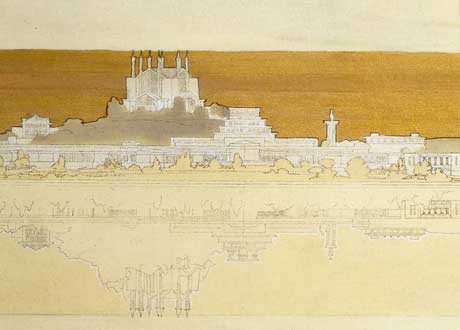
Detail from ‘Section A–B Northerly Side of Water Axis: Black Mountain to Lake Park’
showing the central railway station and cathedral. Illustration by Marion Mahony Griffin, 1911. National Archives of Australia: A710 42
Canberra centenary celebrations
Thursday 15 August to Saturday 17 August
On the centenary of Walter Burley Griffin’s arrival in Australia, the Walter Burley Griffin Society is celebrating the Griffins’ Canberra as part of the Canberra 100 program of events. Walter Burley Griffin first arrived in Australia in August 1913 after winning the international competition for the design of Australia’s national capital the year before.
The Society’s celebrations will include:
Marion Mahony Griffin Lecture 2013, Thursday 15 August, 6pm
The Griffins’ Canberra: 100 years symposium, Friday 16 August
Bus tour of the Griffins’ Canberra, Saturday 17 August
See the Events webpage for further information.
Heritage Guided Tours of the Capitol Theatre, Melbourne
Guided tours of the magnificent theatre interior, designed by the Griffins in 1922, are conducted on the third Friday of March, May, June, July, August, September, October and November on a continuous basis from 10am until 3.00pm (last tour start time).
Trained volunteer guides tell visitors of the history of the Theatre, the
changes that have been made over 80 years and show them through the foyers
and the auditorium. There is a short audiovisual presentation on the screen
at the end of the tour. A gold coin donation, per person, would be
appreciated.
No bookings are required for groups under five persons; over five it would
be best to contact Kay Kinder, the Booking Officer at RMIT on
(03) 9925-1773 to make a booking so extra guides can be in attendance.
PUBLIC MEETING
Save The Lake Shore –
Stop these unnecessary memorials!
Wednesday 23 March 2011, 7.30pm
Albert Hall, Canberra
This public meeting with a panel of eminent speakers has been called
by the Lake War Memorials Forum, a group of concerned organisations
including the Walter Burley Griffin Society’s Canberra Chapter.
Operating behind closed doors and indifferent to overwhelming
public opposition, a group called the Memorials Development Committee
has been allocated land on the shores of Lake Burley Griffin to construct
two unsightly, unnecessary monoliths which have been rejected by many
veterans. The existing Australian War Memorial provides a fitting monument
to those who served in the two world wars.
The Walter Burley Griffin Society is concerned about the adverse impacts
on Griffin’s land axis and the design and vistas of his National Capital plan.
Further information:
www.lakewarmemorialsforum.org

Photo montage Karina Lee, reproduced with permission of the Lake War Memorial Forum
Grandiose war monuments are a flawed proposal for Canberra
9 November 2010
The proposed WWI and WWII Memorials, that would stand as 20 metre towers, are a grandiose scale that if built would be detrimental to the recreational foreshore parklands, and impede the Griffin vista towards Mt Ainslie. This vista creates appreciation of the natural form of the mountain, as intended by Griffin and the open nature of the Vistas in both north and south directions i
The Land Axis and clear vista are fundamental, enduring elements of the 1912 winning design for the National Capital. The memorials would break the length of the Land Axis and narrow the width of Griffin’s ‘Parkway’ (Anzac Parade). Moreover the Lake foreshore is a horizontal, flat landscape that would be upset by the pronounced vertical towers.
Griffin envisaged that the city would develop around his parkway, using the lakeside gardens as a promenade between cultural and recreational facilities. He never wanted it to be overburdened by the memory of war.
On any sunny weekend a great many people and groups, including tourists, can be seen all over the terraces enjoying picnics, games, walking, cycling and sports. The ambience is conducive to these activities. One enjoys unhindered vistas to iconic buildings, structures, mountains and the passing scene on land and water. The towers and other structures of the war memorials would create an altogether different and much less enjoyable ambience and outlook, practically monopolising the site.
The presumption of a military theme displacing recreational, cultural and other national symbolic themes and achievements is unacceptable.
The Australian War Memorial at the foot of Mt Ainslie is perhaps the most memorable Vista in Canberra because it has a human scale, engages our emotions, and engages us with the dramatic natural form of the mountain. The building at the foot of the Mountain speaks honestly and nobly.
There is a great difference between memorialising the realities of war and monumentalising them. The siting and excessive size of the proposed monuments would diminish the Land Axis, Mt Ainslie and the Australian War Memorial.
The Walter Burley Griffin Society reaffirms its opposition to these memorials at the Rond Terraces near the foreshore of Lake Burley Griffin.
Prominent Australians Oppose Memorial media-information session
Wednesday 2 February 2011, 11:00 am to 11:30 am
A media-information session and website launch will be held at St John’s Church hall, Constitution Ave., Reid.
A group of prominent Australians has announced its opposition to a proposed new memorial to World Wars I and II on the shores of Lake Burley Griffin.
Despite strong public protest when this project was first announced, work has apparently continued behind closed doors, with citizens’ views being either ignored or not sought.
The Lake War Memorials Forum has been established to give all Australians the chance to express their views.
All media and members of the public are warmly invited to attend.
For further information
www.lakewarmemorialsforum.org
Designing for Canberra
National Archives of Australia Speakers Corner
14 November 2010, Canberra
This occasion was a fascinating discussion with the award-winning architect of Australia’s Parliament House, Aldo Giurgola and colleagues Hal Guida and Pamille Berg, about the challenges and opportunities of integrating the design of Australia’s Parliament House with Walter Burley Griffin’s original vision for the national capital.
The three architectural colleagues provided a wealth of candid reflection on their planning of Parliament House.
Romaldo Giurgola listed order, simplicity, human relationships, humanity, symbolism and the natural environment as objectives. He aimed for the health and wellbeing of the people and not Texas-style ‘vibrancy’ and above all not ad hoc planning. He abhors ‘conversations’ that never end, instead of genuine community engagement based on leadership vision, public interest criteria and model demonstration. This long term visionary and design approach has given way in Canberra to timid government reaction to developers.
He believes Canberra has reached a critical point where urban planning has become ad hoc and default. To keep its character alive, Canberra must take a knowledgeable, intelligent, regional and community wellbeing approach.
While all three panelists spoke frequently about Griffin’s fundamental and lasting influence on their work, the moderator Tony Powell studiously tried to marginalise and misrepresent Griffin.
Romaldo Giurgola continues to be an active member of the Walter Burley Griffin Society.
Designing for Canberra – notes by Brett Odgers.pdf
to top
MEDIA RELEASE |
21 October 2010 |
Released by the Walter Burley Griffin Society Inc.
and the Castlecrag Progress Association Inc.
COURT REFUSES CASTLECRAG DEVELOPMENT PROPOSAL
“TOO BIG FOR THE SITE”
The Land and Environment Court this week delivered a strong judgement rejecting a development application for a large new residence in the Griffin Conservation Area in Castlecrag.
The President of the Castlecrag Progress Association James Fitzpatrick and the President of the Walter Burley Griffin Society Professor James Weirick today said that the large community membership of both organisations would be very pleased with this outcome.
The case against the refusal by Willoughby Council, followed several amendments to the applicant’s development application for the site over the past two years.
In her judgement refusing the appeal concerning 95 The Bulwark Castlecrag, Commissioner Sue Morris said “The planning principles for the Griffin Conservation Area must be upheld to ensure that the importance of this area is not lost to large scale, non-sympathetic forms of development that do not respect the natural environment and landscape setting.”
Professor Weirick said, “The point of Willoughby Council’s planning and development controls is to preserve the principle that buildings should be subordinate landscape in the unique garden suburb of Castlecrag designed in by Walter Burley Griffin and Marion Mahony Griffin on the shores of Middle Harbour in the 1920s and maintained through community support to the present.”
The main issues in the matter were the size, bulk and scale of the proposed dwelling, whether compliance with the height control was unreasonable and unnecessary and the impact of the development on the Griffin Conservation Area.
At the Land and Environment Court site inspection, submissions were made to the Commissioner by Professor James Weirick, for the Walter Burley Griffin Society, Peter Moffitt for the Castlecrag Progress Association, and several local residents. In the Court, expert witnesses included heritage experts, arborists, and planners.
The Commissioner also found: “The Griffin Conservation Area is an area of high heritage significance and contains a number of individual heritage items. It is clear from the extensive planning controls that apply to the site and the clearly articulated statement of desired future character for the area that the community expectation is that development of the area will remain subservient to the landscape setting.” . . . “A merit assessment of the application has also shown that the application is not appropriate for the site in its context and that there are other design alternatives for the site which would meet the planning controls. . .”
The Commissioner found that the proposed development “fails the principle of being subordinate to the landscape setting” and “The dwelling is too big for the site”.
James Fitzpatrick said, “We commend Willoughby City Council on defending their judgement to refuse this application in the first instance. This judgement is thorough and recognises the unique values of the Griffin Conservation Area in Castlecrag. The Progress Association hopes that this will provide a strong indication of the importance of the Griffin legacy, and the need for future developments throughout the suburb to observe the planning controls which protect those values. I believe that the majority of the Castlecrag community would be very supportive of the court’s decision. We congratulate Willoughby City Council on defending this case.
The whole Judgement can be read on the Land and Environment Court website.
to top
The Way Forward? Can Canberra’s planners learn from Washington?
Brett Odgers and Bruce Kent pose this question one year after the Rudd Government promised to fix the National Capital’s planning system. An edited version of their article below was published in The Canberra Times in early January 2010.
The National Capital Authority’s Public Forum at Parliament House on 26 November 2009 showed that the Canberra community takes a keen interest in the planning of the National Capital. It also demonstrated the deep and ongoing problems in planning the city.
The manifest problems in Canberra’s planning system (the subject of Professor Jenny Stewart’s article, The Canberra Times, 7.12.09 p.9) are due in large degree to the settlement over self-government in 1988 but have intensified over the past few years.
The opportunity to review the division of governmental responsibilities for Canberra was not taken last year on the 20 years anniversary of ACT self-government. However, the Parliamentary Joint Standing Committee on the National Capital and External Territories report The Way Forward (July 2008) recommended some reforms in NCA governance, consultation, coordination with the Territory government and compatible plans.
The Commonwealth Government’s response on 12 December 2008, accepted 13 recommended reforms in full or in principle and noted another five. However, they were referred to a task force, to report within three months on NCA functions and governance reforms, and an intergovernmental committee was to report within 12 months on the alignment or coordination of the Territory and federal planning bodies and statutory plans. Both committees have been working behind closed doors.
The issue of most concern to the JSC and at the recent NCA Public Forum was the inadequate provision for meaningful consultation between the NCA and community stakeholders. The Canberra community is, as one would expect, highly sensitised to the bureaucratic ‘pipeline effect’ – the tendency of plans and developments to become virtually unstoppable in the minds of their authors once they have been approved in principle or even at the concept stage. It was in order to counter the ‘pipeline effect’ that the National Capital Development Commission (NCDC), which shaped Canberra before the advent of self-government in 1988, was advised by a National Capital Planning Committee (NCPC).
This body consisted of the NCDC Commissioner, together with two architects, two engineers, two town planners, and two other persons ‘with special knowledge and experience in artistic and cultural matters’, appointed by the Minister from lists provided by professional bodies. Throughout the life of the NCDC the NCPC regularly reviewed all the major matters of planning and development under reference from the Commission before they entered ‘the pipeline’.
The current impasse between planners and citizenry in Canberra would be allayed if a similar body were established, along the lines of the National Capital Consultative Council recommended by the JSC. It would include representatives from the two governments, the community and business and be co-chaired by the federal Minister and the Chief Minister. It is to be hoped that this Council, agreed in principle by the federal Government a year ago, will be confirmed by Minister Brendan O’Connor, not only to defuse counter-productive disputation within Canberra but also to strengthen the arm of the beleaguered NCA against pressure from government departments and developers.
Washington DC is guided by such a National Capital Planning Commission (NCPC). It also has democratic processes for the development of monuments and memorials in the National Capital. The land bank of suitable locations is precisely monitored and identified. Canberra has no such care and scrutiny.
A related matter which vitally affects the development of the National Capital is the location of responsibility for ACT planning and development within the appropriate Commonwealth portfolio. The issue was broached in Recommendation 8 of the JSC Report that there should be consultation about the Canberra Airport Master Plan between the NCA and the Department of Infrastructure, Transport, Regional Development and Local Government. In view of the inability of recent incumbents of the Home Affairs portfolio to pay sufficient attention to National Capital planning and development matters, there is a strong case for relocating responsibility for the ACT to the infrastructure, urban and regional planning portfolio.
The JSC recommendations on ‘the dual planning framework’ between the Commonwealth and ACT governments and ‘vision for future planning’ were decidedly weak and regressive. The Government’s response was even more ominous, being cast in terms of ‘simplification and removing duplication.’ They were an invitation for the Commonwealth to eliminate ‘areas of special national requirements’ and hand over (‘uplift’) to the Territory government portions of the ‘designated areas.’ It presupposed delegation and cooperation; and envisaged combining the Territory and National Capital Plans into one accessible document.
Canberra needs an integrated, unified and capable planning organisation geared to the idea and the ideal of the National Capital, strategic planning, deep sustainability, a real land use and transport strategy and specific controls over, say, location of federal offices and the National Capital Open Space System. The Territory Plan, the Spatial Plan and the National Capital Plan are all long overdue for substantive review and for sustainability integration into a metropolitan strategy.
Twelve months ago, however, all that the Commonwealth Minister could foreshadow was ‘The Commonwealth will consult with the ACT Government on matters relevant to the holistic development of Canberra as the National Capital.’ How confident can we be about the awaited decisions on The Way Forward by the Rudd Government?
Brett Odgers and Dr Bruce Kent
to top
Plans for proposed Immigration Bridge abandoned
As reported in The Canberra Times on 30 March 2010 “The controversial Canberra Immigration Bridge proposal is dead. Its proponents … have abandoned their plans to commemorate the contribution of migrants to Australia by building a 400m footbridge across Lake Burley Griffin.
Instead, the group will push for a land-based monument within the Parliamentary Triangle.
… The announcement is expected to be hailed by the yachting and rowing fraternities which lobbied hard against the bridge because it created an obstruction to lake users, as well as heritage groups which thought the bridge was contrary to the vision of Walter Burley Griffin because it cluttered the lake.”
Last year the Walter Burley Griffin Society was involved in the inquiry of the Joint Standing Committee of the National Capital and External Territories into the Immigration Bridge Proposal. The Society made four written submissions and gave verbal evidence to the parliamentary committee. Professor James Weirick’s 43 page submission provided an historical and analytical case study of the structural collapse of the current administration of the National Capital Plan.
This news of the proposal being abandoned is very welcome, as the proposal if constructed would have impeded the main central area vistas, altered the shape of West Basin and Griffin’s lake symmetry, detracted from the Water Axis, obscured the diagrammatic separateness of the Parliamentary Triangle and potentially transformed West Basin into an uneven shaped pond to embrace intense development from the expanding CBD.
The Canberra Times reported that the NCA’s chief executive Gary Rake had said that while the National Capital Plan did make provision for a pedestrian bridge in the general location spanning from Acton Peninsula to near Lennox Gardens, any bridge there would ultimately have a negative impact on the heritage values as outlined in the heritage management plan for the area.
The Society’s president Professor James Weirick has said: ‘The Walter Burley Griffin Society supports the creation of an Immigration Gallery and Meeting Hall at the National Museum of Australia as a living celebration of the immigration story in Australia’.
MEDIA RELEASE 15. 1. 2010
High rise proposal blight for Canberra
A proposal for a 17 storey building not far from the foreshores of Lake Burley Griffin is unacceptably unsympathetic to the National Capital Plan but is currently on public notification by the National Capital Authority (NCA). The proposed development is at the end of Edinburgh Avenue south of the heritage Hotel Acton, overlooking Parkes Way.
The height and scale of the proposal called ‘Nishi’ on this location is at odds with the geometry, landscape design and symbolism of the Griffin Plan. Perusal of the planning report, design report and architectural drawings submitted by the proponent in support of the works application make no reference to the Griffin Legacy or the National Capital Plan.
Walter Burley Griffin rejected towers. He emphasised that buildings in Canberra should be horizontal, not vertical “... the necessity of making these large units stand end on end, as in the congested American cities, can be avoided in a Capital City, securing a horizontal distribution of the large masses for more and better air, sunlight, verdure and beauty.”
Professor James Weirick has pointed out that the principle of horizontal building masses in the design of Canberra is particularly important.
The National Capital Plan ‘Policies and Standards for Urban Design’ inscribe the principle that “Buildings in Central Canberra should be of a height generally not greater than the height of the mature tree canopy (typically 3 to 4 stories).” The principle is fundamental to the character of the city created since the 1920s.
Brett Odgers from the Canberra Chapter of the Walter Burley Griffin Society states that “This proposal would impair important Central National Area vistas, and it foreshadows the proposed commercialisation and privatisation of West Basin, a vital formal component of the symbolic, Griffin Plan core of the National Capital. Such appropriation of public land in Washington, the American national capital, would be unthinkable and should be here too.”
The height and scale of this works proposal is insensitive and ill conceived. It needs to be rejected to ensure that the symbolic national area of Canberra is not adversely impacted. Similarly Amendment 61 for West Basin needs to be reviewed so that Canberra’s heritage and major assets of foreshores and the vistas across the Water, or Nature Axis to Acton Ridge and Black Mountain are retained and not adversely affected.
Intrusive plans for new ASIO headquarters
An overview of Walter Burley Griffin’s Plan for the National Capital would include the land and water axes, the National Triangle, Capital Hill, its radiating avenues, democratic symbolism, constitutional diagram, landscape settings and vistas. Seeing Marion Mahony Griffin’s competition drawings and looking today from Parliament House or Mount Ainslie over central Canberra, these features are still wonderful to behold.
However distinctive features of the National Capital Plan are currently under major threat from a series of Plan amendments, construction projects, approved developments and planning consultancies.
Deviations from Griffin’s Plan are not unprecedented but this time they are being conducted misleadingly in the name of Griffin himself.
In order of magnitude of impact, one of the worst would be the massive ASIO headquarters which will sit directly across the lake from the High Court and the Parliamentary Triangle, between Constitution Avenue and Parkes Way and just a stone’s throw from Anzac Parade.
The planned ASIO Headquarters is the largest building project in Canberra after the new Parliament House, and would be a highly visible intrusion in the symbolic centre of Canberra. The site is half a kilometre in length and seven hectares in area. The monolithic building will be a prominent intrusive element from across the Lake at Commonwealth Place, Peace Park and so many other vantage points in the Central National Area and on the hills around.
The large assertive building complex with perimeter security fences and devices would dissipate any attempt to create vibrant streets and active urban spaces. If built the mass and bulk of the project would intrude on the landscape of the most visually sensitive location of Central Canberra.
The project makes a mockery of Griffin’s design for the municipal axis of the great national triangle, intended to be a grand terrace of diverse civic and urban activity. The whole eastern half of Constitution Avenue and fronting Parkes Way will be locked into security and defence offices.
The planned ASIO Headquarters will destroy the balanced symmetrical urban pattern proposed in the Griffin Plan, and detract from the balance and symbolic strength of the Canberra land axis. These impacts will degrade the symmetry, landscape design and symbolism of Walter Burley Griffin’s vision.
The project was developed under wraps without parliamentary or public scrutiny. When the project was referred to the Environment Minister for environmental and heritage impact assessment on 25 March 2009, his delegate approved it on 23 April and the construction site office materialised the next day. Site clearance and construction commenced on 23 May. Yet it still requires formal works approval from the National Capital Authority.
It is the responsibility of NCA to safeguard the design integrity of the National Capital’s areas of national significance.
Winter House listed on the State Heritage Register, 9 January 2009
The Winter House, designed by Walter Burley Griffin has been listed on the State Heritage Register. Also known as Redstone, the Winter House was built in 1935 at Telopea in Sydney’s west. The listing was announced by the Planning Minister, Kristina Keneally at a media event at the house on 9 January 2009.
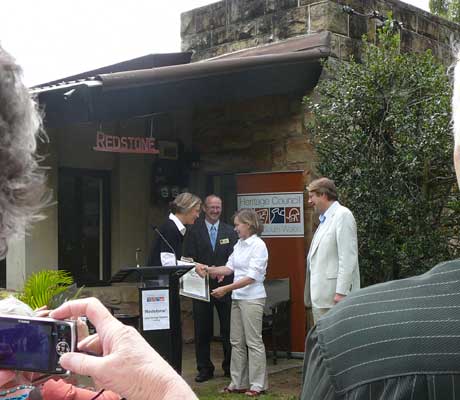
The Minister for Planning the Hon. Kristina Keneally MP presents Winter House owner Mrs Kerry Lee with the Certificate of State Heritage Register Listing. Mr Tim Smith, Deputy Director, Heritage Branch, Department of Planning, and to the right Professor James Weirick, President of the Walter Burley Griffin Society look on.
The Winter House has exceptional intactness and integrity, and is the last Griffin house still remaining in the ownership of the family who commissioned it.
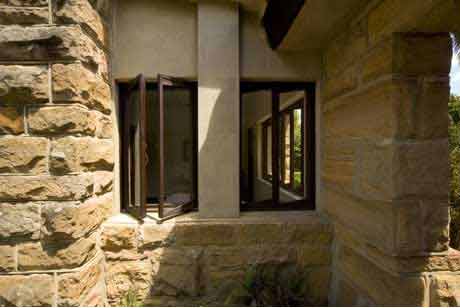
The Winter House 2008. Photographer Eric Sierins
The house is an example of Griffin’s development of Prairie School principles that had their origin in the landscape-inspired houses of the early modern movement in Chicago.
The house is sited at the top of a rise within the Parramatta Valley with long views towards the Blue Mountains. It responds to the broad, open site of the undulating Cumberland Plain at Dundas. It is well set back on the intact original block, retaining its intended setting and layout.
Minister’s Media release_Redstone.pdf
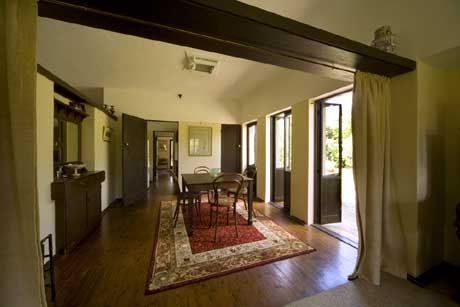
The Winter House 2008. Photographer Eric Sierins
to top
Commonwealth Government response to the parliamentary inquiry into the National Capital Authority
The report and recommendations of the Joint Standing Committee on the ACT issued its report on the role of the NCA in July 2008. The Hon. Bob Debus MP, Minister for Home Affairs, indicated that the Government would respond by December 2008. He and the acting Chair of the NCA, Professor Don Aitkin, together with Senator Lundy who chaired the Committee, have all recently expressed in public strong positive sentiments about “all Australians share a high regard for Canberra” (Debus), “the vision splendid for the National Capital” (Lundy) and “the unfinished business of Canberra” (Aitkin) and “the special quality of human beings, their buildings, the site and the environment existing in a special harmony” (Aitkin).
The report of the parliamentary Committee stated as the first objective “to ensure the Commonwealth protects the unique design of Canberra because it represents the intrinsic character of the National Capital.” At paragraph 1.17 this unique design is described as “Griffin’s plan.”
This was the third major inquiry in four years by the Committee into the performance of the NCA. They established the case for reforming the NCA to be more accountable and responsive. The 2007 report called upon the NCA to review and revise its so-called “Griffin Legacy” Amendments to the National Capital Plan. By 2008 the public disquiet and deep-seated problems associated with the NCA merged with concerns about the dual planning system instituted upon ACT self government in 1989 and growing public perceptions of falling standards in Canberra’s metropolitan planning, infrastructure, public architecture and sustainability.
Issues addressed in the Committee’s report include the NCA’s role and governance, consultation with the community, protection of Canberra’s heritage, Canberra Airport, location of Commonwealth government offices, the transport system, the dual planning system and strategic planning for National Capital and sustainability.
The report gives an even-handed representation of all the wide interests conveyed by written submissions (136) and witnesses (50 over seven public hearing days). The general tenor of the report could be characterised as pragmatic, conservative, moderate, balanced. It is strongly evidence-based and conveys a strong, comprehensive and determined dynamic towards a much improved National Capital planning system. The direction and scope are commendable.
The principle recommendations are more orthodox NCA governance, increased NCA accountability through the Parliamentary Committee on the ACT and much enhanced responsibility of the NCA through the creation of a National Capital Consultative Council (NCCC). The NCA Board should consist of a Chairperson and seven members, with a minimum “two members from the ACT region.” One Commonwealth appointee at least must have relevant expertise.
The NCCC “would have representatives from the Commonwealth Government and the ACT Government, the community and business. The Council would be co-chaired by the responsible Minister and the ACT Chief Minister.”
There is a recommendation that the Commonwealth establish the position of Commonwealth Architect within the Department of Prime Minister and Cabinet.
These recommendations presuppose a new Commonwealth Government commitment to the National Capital and to closer collaboration with the ACT government. The complementary recommendations on the dual planning system, statutory amendments and memoranda of understanding, are however about weak rather than strong integration.
Moreover, there is a confusing and complex recommended set of new and revised “Land Use Plan, Integrated Plan, NCA Plan, single integrated overarching document, Implementation Strategy and policy plans” rather than an emphasis on a new Metropolitan Strategy Plan and one integrated planning organisation. The perpetuation of the problematic dual planning system is compounded by a recommendation for a “geographic re-alignment of land administration with planning responsibility.”
The recommendations for control over Canberra Airport, location of Commonwealth government offices and formulation of a transport plan are similarly incremental and questionable. Sustainability is to be achieved through a “principle imbedded” in legislation, the new and revised Plans and Strategies, transport plan and an MOU on administrative collaboration. The Committee avoided the issue of security-related developments such as the ASIO/ONA complex and federal Parliamentarians have recently reaffirmed their exemption.
The NCA’s record on public consultation is abysmal but the Committee’s recommendations do not advance the cause, other than community representation on the NCCC.
The Committee refrained from making recommendations on general funding and professional planning resources, other than “NCA be resourced to participate in working parties and reviews as required” and the ACT Planning and Land Authority to be resourced for planning under delegations in National Capital “Designated Areas.”
It is hoped that many of these issues will be debated in due course. Already ACT Senator Gary Humphries (a member of the Committee) has organised a public forum for 17 November 2008 to discuss the recommendations. The Inquiry and the directions recommended in the Report are constructive and dynamic. The Government’s response is keenly awaited.
Brett Odgers
11.11.08
to top
The Magic of America published online
The Art Institute of Chicago has made Marion Mahony Griffin's great work The Magic of America available online. This is a very great achievement by Ed Fishwick, Mary Woolever and other staff at The Art Institute of Chicago – and above all, a very great day for Marion, as after almost 60 years her work is now available worldwide.
To quote from the website: "The Magic of America a typescript of over 1,400 pages with approximately 650 accompanying illustrations, was written and compiled by Marion Mahony Griffin (1871-1961), architect, designer, delineator, and artist. In 1911 she married Walter Burley Griffin (1876-1937), architect, landscape designer, and city planner. Their architectural practice spanned almost four decades on three continents, and The Magic of America was meant, in part, to be a testament to their life and work together.
The Magic of America: Electronic Edition was launched on 28 August 2007, and collates in a digital format all the texts and illustrations from the three known copies of the work. The electronic edition thus represents the most complete and accessible version currently available of this important architectural document."
The Magic of America: Electronic Edition is available at
http://www.artic.edu/magicofamerica/
Winter House nominated for listing on the State Heritage Register
The Walter Burley Griffin Society Inc is very pleased that the Heritage Council of NSW intends to consider listing theWinter House (also known as Redstone) on the State Heritage Register. The Society fully supports listing the Winter House designed by Walter Burley Griffin and completed in 1935. It is a house of outstanding significance.
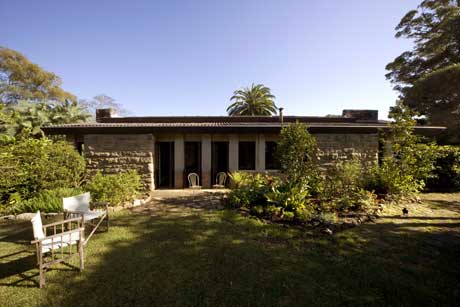
Winter House, 2008. © Eric Sierins photographer
The Winter House is one of the most significant 20th century houses in western Sydney, and as the Heritage Branch’s nomination report states it has “exceptional intactness and integrity” retaining all its original interiors, fixtures and fittings. It is “the last Griffin house still remaining in the ownership of the family who commissioned it. ”The family is praised highly in the report “for having employed high quality heritage advice in its maintenance and repair since the 1970s, ensuring that it has been conserved according to Burra Charter principles.”
“Redstone remains almost unaltered in its structure and layout” and “is of State heritage significance for its aesthetic qualities as a fine work of architecture and an outstandingly intact example of Walter Burley Griffin's small-scale house design. It contains many of the features for which Griffin is highly regarded including open planning, juxtaposition of robust stonework with fine oiled timber joinery. ... The gracious garden retains trees and other species planted by the original clients and its design has been largely unaltered since 1953.”
The house is an example of Griffin’s development of Prairie School principles that had their origin in the landscape-inspired houses of the early modern movement in Chicago. The house is sited on a rise in the Parramatta valley and has long views to the Blue Mountains, and responds to the broad, open site of the undulating Cumberland Plain at Dundas.
Further details on the nominated item, and making a submission (submissions close 19 November 2008) can be viewed at
www.heritage.nsw.gov.au/listing
Due to the generosity of the owners, more than seventy people enjoyed viewing the Winter House, its beautiful grounds and wonderful intact interiors on Sunday 26 October 2008. The Society’s twentieth AGM was held in the garden with heritage architect Ian Stapleton as guest speaker who spoke on the recent restoration work.
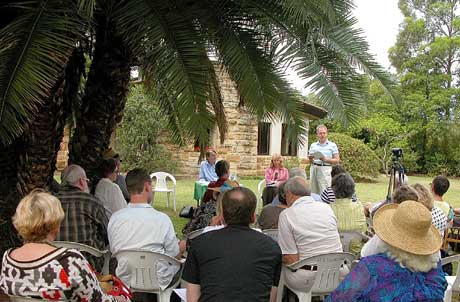
The Society’s twentieth AGM in the garden of the Winter House, 2008. Photgrapher Michael Thomson
12. 11. 2008
Proposed planning ’reforms’ threaten NSW heritage
The proposed reforms to the New South Wales planning system involve measures that, if implemented, pose significant threats to our built heritage.
The NSW state government revealed its sweeping proposals in November 2007 in a discussion paper titled ’Improving the NSW Planning System’. In its submission in February 2008, the Walter Burley Griffin Society outlined issues that would be damaging to heritage generally and the Griffin Conservation Area at Castlecrag in particular. The Society’s full submission can be viewed below as a pdf.
In its submission (to briefly summarise) the Society stated that:
- the proposed standardisation of development consent conditions has the potential to irreversibly damage the highly sensitive and unique heritage of the Griffin Conservation Area;
- the proposed mandatory default code to define exempt and complying development which would allow for non-compliance, if introduced as a single statewide code, would be a counterproductive and backward step;
- existing council DCP standards that have been developed with extensive community input to address the special circumstances of environmentally sensitive and heritage areas (such as the Griffin Conservation Area) should be accredited as the complying code; and
- that proposals ‘to extend the ambit of exempt development’ should not be applied to heritage areas, particularly not the Griffin Conservation Area.
The state government received 538 submissions in response to the discussion paper. Since then on 3 April the government released its Environmental Planning and Assessment Amendment Bill 2008. The media release from the Minister of Planning Frank Sartor that accompanied it states the draft bill is “the first legislative step towards reinvigorating the NSW planning system. … Mr Sartor said many of the key reforms outlined in the discussion paper were reflected in the exposure bill”.
The bill has ignored the arguments put forward in the submissions and continues to seek a significant dumbing-down of standards both in urban design and architecture. The proposed blanket approach, if enacted, would inevitably lead to poor-quality outcomes.
The situation is summed up well in Moir’s cartoon in the Sydney Morning Herald of 7 April where Sartor, in the guise of Napoleon, sits at his desk with a sign behind him proclaiming “NSW Government … for the people in property development”
Public comment on the Bill closes on 24 April 2008.
Further information
WBGS letter-Planning reforms.pdf (140KB)
www.planning.nsw.gov.au/planning_reforms/index.asp
www.keepitlocal.org.au
Griffin and Modernism in Lucknow 1930-1970
Architectural seminar, Integral University, Lucknow, India
The Cultural Heritage Educational Initiative was established in 2002 by Mary Kay Judy and local educators in Lucknow, Uttar Pradesh, India to promote local preservation through education and greater public awareness.
Griffin and Modernism in Lucknow: 1930-1970 held in March 2007 was the first seminar to focus on the concept of Modernism as heritage. The majority of students were practising professionals and architectural faculty members in Lucknow. The seminar began with a study and investigation of the career of Walter Burley Griffin in Lucknow in the 1930s.
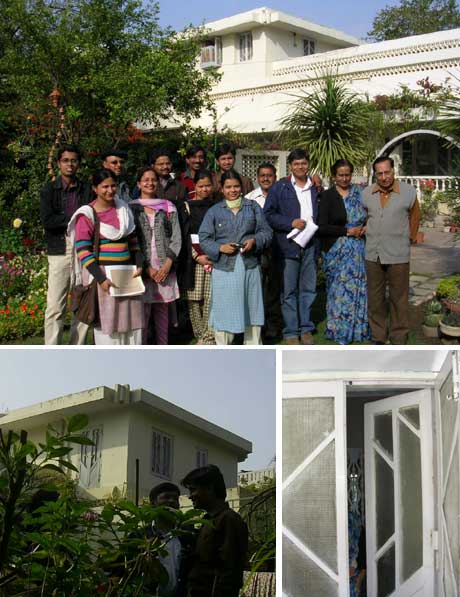
Bhatia House with participants of the Griffin and Modernism in Lucknow seminar with, at right, the Bhatias, owners of the house and descendants of the original Dr. Bhatia, Griffin’s client. Upper storey detail. Front porch door. Photographers: Participants of the seminar, courtesy Mary Kay Judy
Before leaving the classroom for field work, students learned about Griffin’s early career in America at Frank Lloyd Wright’s studio and his years in Australia after he and his wife, Marion, won the competition to design the new Federal Capital, Canberra, in May 1912. Griffin initially went to Lucknow in 1935 to design the University Library. He also designed the United Provinces Agricultural and Industrial Exposition grounds and buildings, a series of commissions for private residences and the Pioneer Press newspaper building. Unfortunately, most of these buildings and his legacy in India have been lost to history.
When Griffin was introduced in the seminar, most students were unfamiliar with his work, connection to Wright, or his role in local Lucknow architectural history. Using archives from the Avery Architectural Library in New York City of the original Exposition plan, renderings and drawings of his commissioned work in Lucknow, and donated copies of Two American Architects in India: Walter B. Griffin and Marion M. Griffin 1935-37, by Paul Kruty and Paul E. Sprague, the class sought to find any remaining evidence of his work and retrace his career through the city.
The Bhatia House was visited by Mary Kay Judy and the students as part of the seminar program. The house was designed by Griffin for Bir Bhan Bhatia a professor of science from Lucknow University. Dr Bhatia’s descendents still live in the house which is rapidly being surrounded by high rise apartments.
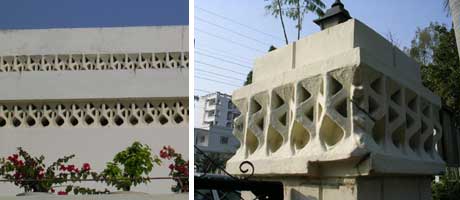
Details of the Bhatia House parapet and gate post at street. Photographers: Participants of the seminar, courtesy Mary Kay Judy
Griffin’s work and local contributions became a starting point for analysing early Modernism in Lucknow followed by a critical analysis of the thirty most significant local Modernist buildings dating from 1930-1970, identifying many works by significant Indian architects such as Achyut Kanvinde. During the seminar, international organisations that promote preservation of the Modern Movement were introduced, such as DoCoMoMo and the World Monuments Fund, and the work of the Walter Burley Griffin Societies in the United States and Australia.
Albert Hall public meeting of 24 May 2007
On the evening of 24 May, in response to mounting public concern over the NCA’s Draft Amendment 53, more than three hundred people attended a very successful meeting to discuss the future of the Albert Hall and its precinct. Among the speakers were the Convenor of the Friends of the Albert Hall, Dr Lenore Coltheart, the co-ordinator of the meeting, Di Johnstone, WBGS Committee member, Rosemarie Willett, Head of the ACT Heritage Unit, Dr Michael Pearson, ACT Senators Garry Humphries and Kate Lundy, ACT Planning Minister, Andrew Barr, and NCA Chief Executive, Annabelle Pegrum.
The main focus of the Meeting was on two separate, but related, issues:
1. The conservation and use of the Albert Hall; and
2. The proposals in the NCA’s Draft Amendment 53 to the National Capital Plan for the redevelopment of the Albert Hall’s ‘precinct’ stretching from the Hall to the Lake shore both to the west and to the north, as far as the southern approach to the Commonwealth Bridge.
With respect to the Hall itself, which is currently managed by the ACT Government, the meeting overwhelmingly rejected (in Resolutions 4 and 6) the latter’s premature attempt to privatise the Hall by calling for tenders for its management and upkeep before agreement had been reached about its use and the future of its precinct. The grounds for these resolutions were (a) that a private manager would not be able to fund the outlays of $1 million plus needed to restore and refurbish the Hall and (b) that such a manager would naturally lease the Hall to high rental commercial clients to the exclusion of the many less affluent cultural groups which had hitherto hired the Hall. The meeting was informed that, in an effort to resolve the problem of the financial responsibility for the Hall, the ACT Government had just announced that it intended to suggest to the Commonwealth Government that the building should be nominated for National Heritage listing.
With regard to DA53, dealing mainly with the Albert Hall precinct, there was a collision between the meeting and the NCA, reflected in the near unanimous resolutions 1 and 2 that DA53 should be withdrawn and that fresh planning and consultation processes should be instituted via a joint body set up by the Federal and ACT Government with ‘equal community representation’. This was at odds with an NCA proposal on the eve of the meeting that, because of changes which had already been made to DA53 (most notably the scrapping of a proposed ‘landmark’ eight storey building adjacent to Commonwealth Bridge), the amendment would be ‘re-released’ after further consultations and workshops ‘in the near future’. The determination of the meeting to restart the planning process from scratch was inspired by the view of the overwhelming majority:
(i) that the NCA’s commercially-slanted proposals would hamper the restoration of the Albert Hall precinct as a community cultural centre;
(ii) that DA 53 flouted the principles laid down by Walter Burley Griffin for the plan of the symbolic central areas of the National Capital’ (Resolution 5);
(iii) that the closure of the clover -leaf road system at the southern end of Commonwealth Bridge, upon which DA 53 was premissed, would cause unacceptable peak-hour traffic congestion in the Parliamentary Triangle and Commonwealth Avenue; and
(iv) that the NCA was currently only prepared to consult about the details of DA53, as opposed to its underlying merits or demerits.
Dr Bruce Kent, 28 May 2007
Further information
Albert Hall resolutions.pdf (48K)
Albert Hall talk Rosemarie Willett.pdf (40K)
www.ouralberthall.com
ACT Government Media Release 24 May 2007
www.chiefminister.act.gov.au/media.asp?media=2571§ion
=24&title=Media%20Release&id=24
to top
Financial interests prevail over democracy and the Griffin legacy.
Senate debate on the Griffin Legacy Amendments to the National Capital Plan
The inadequate consultation process over the momentous amendments to the National Capital Plan culminated on 10 May 2007 in the Senate. Senator Bob Brown’s Motion of Disallowance of four major amendments (Amendments 56, 59, 60 and 61, inappropriately called the “Griffin Legacy Amendments”) formulated by the National Capital Authority came before the Senate on that day.
In his speech introducing his Motion of Disallowance, Senator Brown stated principles and fears, principally on grounds of democracy and the role of the Senate in reviewing Executive responsibility.
Given the intensive efforts from many quarters to lobby all Senators over the issues, the debate and ensuing vote indicated nearly universal disinterest of federal parliamentarians from the two major parties in their national capital.
Particularly notable was the admission by ACT Senator Lundy (then Deputy Chair of the Parliamentary Joint Standing Committee) that the JSC was misled by the National Capital Authority. Instead of a normal inquiry they opted to have a short reference one-day roundtable hearing, only to be surprised and astounded by the passion, depth and spread of informed and expert objections to the Amendments manifested at the roundtable. This was reflected in the committee’s critical report (March 2007). Lundy castigated the NCA saying “serious questions should be asked about how their so-called thorough consultation” was really carried out. However Senator Lundy stopped short of supporting the recommendations of the JSC, of which she was part.
Remarkable was ACT Senator Humphries’ absence from the debate, and also from the vote. There were only 7 votes in favour (4 Greens and 3 Democrats) of Senator Brown’s motion to disallow the Amendments. In a stirring final speech Senator Brown spoke of the “magnificence of this green capital” and referred to the need for more reflection over the Amendments, and to the grave risks in not incorporating rules and guidelines. He also raised doubts about the lower tiers of regulation being able to protect and ensure a sustainable Canberra, and concerns about the limited assessments and public participation and the scope for vested interests to prevail over vision and principles.
Further information
Senate Official Hansard transcript of debate, Thursday 10 May 2007. Refer to pages 22 to 33 for Senator Bob Brown’s speech and the debate. www.aph.gov.au/hansard/senate/dailys/ds100507.pdf
Griffin Society wins prestigious award for its website
The Walter Burley Griffin Society website has won the 2007 EnergyAustralia National Trust Heritage Award for Interpretation and Presentation, Community Groups. The National Trust awards have been described as the ‘Oscars’ of the heritage world.
Meredith Burgmann, President of the Legislative Council, and ABC broadcaster David Marr presented the awards at the Westin Hotel in Sydney on 12 March 2007.
The website, which went live in mid 2006, promotes a greater understanding and appreciation of the work of Marion Mahony Griffin and Walter Burley Griffin and encourages the conservation of their extensive work. It contains thirty-five sections covering the lives and works of Walter and Marion Griffin, the influences that shaped their work and an impressive photo gallery. These were written and designed by members of the society with expertise in various fields. The site also contains downloadable student activity sheets for primary and secondary school teachers.
In selecting the Griffin website for the award, the judges said: ‘It is an impressive achievement from a community-based organisation, about important 20th century architects. It deals with their work both in Australia and overseas.’
The informative heritage site also received praise from members of the community. Scott Robertson, an architect and member of the National Trust’s Urban Conservation Committee said: ‘it is still one of the best, most useful websites I have seen and used. A model of what information websites should be’.
The use of the internet and the electronic media is becoming an important tool in conservation. Tina Jackson, Executive Director of the National Trust of Australia said: ‘Just as heritage may be intangible -- much more than just bricks and mortar -- we must use electronic communication to get the heritage conservation message across to new and wider audiences.’
Adrienne Kabos, the committee member of the WB Griffin Society who oversaw the development of the website, said: ‘the website is the work of a team of 30 people and this award is a very nice acknowledgment of their expertise and commitment’.
Congratulations go out to all those in the community involved in the project.
Jacqueline Levett
to top
Canberra’s Griffin legacy under threat
The issue
Central Canberra and the foreshores of Lake Burley Griffin are poised to be developed with high rise and high density containing excessive residential and commercial space. Such detrimental development would be irreversible and permanent.
Four major amendments to the National Capital Plan formulated by the National Capital Authority (NCA) will come into force unless they are disallowed by Parliament on 10 May.
The Amendments contain no urban design controls to ensure quality urban landscapes and architecture, and show no regard for accepted principles of sustainable city planning.
The Walter Burley Griffin Society is concerned that Griffin’s name has been wrongly used to advance mediocre outcomes that will compromise Canberra forever.
Although called ‘The Griffin Legacy Amendments’, they fail to reflect Griffin’s ideals and intent for urban vitality, diversity, landscape design, sustainability nor a community friendly city. Instead the Amendments, if carried out, would perpetuate the Canberra syndrome of isolated buildings, and dominance of the car, and introduce large areas of high-rise buildings that would dominate the landscape of the ‘Bush Capital’.
Recent history
On 6 December 06, in a break with convention, the Amendments were tabled in both Houses of Parliament prior to the Australian Parliament’s Joint Standing Committee on the National Capital & External Territories (JSC) commencing its own inquiry.
On 23 February 07, the JSC held a roundtable public hearing into the four Amendments to the National Capital Plan proposed by the NCA. Senator Ross Lightfoot, the Chairman of that Committee stated that: “The Griffin Legacy amendments are some of the most significant and far-reaching changes to the National Capital Plan ever undertaken.”
On 22 March 07, the JSC Chairman Senator Lightfoot and his committee of Senators and Members of the House of Representatives published its 80-page report, including a recommendation that the Griffin Legacy Amendments be disallowed so that the NCA has the opportunity to refine the Amendments. As Senator Lightfoot stated “This fine tuning is necessary and in the interests of Canberra and the nation”.
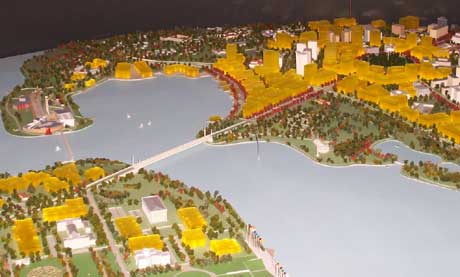
ABOVE: NCA model at Regatta Point showing the Lake infill at West Basin with hotel and conference centre, and at right highrise around City Hill that would dwarf this landmark and block vistas from Commonwealth Avenue south-west to the mountains.
On 28 March 07, the Leader of the Australian Greens, Senator Bob Brown, gave notice of motion that the four Amendments be disallowed. The motion is set to come before the Senate on 10 May.
Canberra needs your help
Let the Senate know that you care about your National Capital and don’t want it damaged by these Amendments. Contact Senators and request their support for Senator Brown’s disallowance motion. Tell them that you support the recommendations of the Joint Standing Committee and that you want the NCA to refine the Amendments, and properly consult the community and experts.
Individual Senators can be identified for specific appeals and their email or other contacts obtained from www.aph.gov.au/Senate/senators/index.htm or just address to Parliament House, Canberra. Key potential players include:
Senator Ross Lightfoot
Email: senator.lightfoot@aph.gov.au
Senator Kate Lundy
Email: senator.lundy@aph.gov.au
Senator Trish Crossin
Email: www.aph.gov.au/Senate/senators/homepages/contact.asp?id=7Y6
Senator Kim Carr
Email: senator.carr@aph.gov.au
Senator John Hogg
Email: senator.hogg@aph.gov.au
Senator Barnaby Joyce
Email: senator.joyce@aph.gov.au
Senator KerryO’Brien
Email: senator.obrien@aph.gov.au
Senator Nigel Scullion
Email: senator.scullion@aph.gov.au
Senator Natasha Stott Despoja
Email: senator.stottdespoja@aph.gov.au
Senator The Hon. John Faulkner
Email: senator.faulkner@aph.gov.au
Senator Steve Fielding
Email: senator.fielding@aph.gov.au
Senator Andrew Bartlett
Email: www.aph.gov.au/Senate/senators/homepages/contact.asp?id=DT6
Senator Lyn Allison
Email: senator.allison@aph.gov.au
Senator Gary Humphries
Email: senator.humphries@aph.gov.au
Senator Kerry Nettle
Email: senator.nettle@aph.gov.au
Senator Marise Payne
Email: www.aph.gov.au/Senate/senators/homepages/contact.asp?id=M56
Senator The Hon Brett Mason
Email: senator.mason@aph.gov.au
Senator Penny Wong
Email: www.aph.gov.au/Senate/senators/homepages/contact.asp?id=00AOU
Senator Christine Milne
Email: www.aph.gov.au/Senate/senators/homepages/contact.asp?id=ka5
Senator The Hon Rod Kemp
Email: www.aph.gov.au/Senate/senators/homepages/contact.asp?id=WW4
Senator Robert Ray
Email: senator.ray@aph.gov.au
Senator The Hon Kay Patterson
Email: www.aph.gov.au/Senate/senators/homepages/contact.asp?id=LI4
Senator Chris Evans
Email: www.aph.gov.au/Senate/senators/homepages/contact.asp?id=AX5
Further information
News Update No45 April 2007, the newsletter of the Walter Burley Griffin Society Inc
NewsUpdate45.pdf (404KB)
Executive Summary of the Walter Burley Griffin Society Inc’s submission to the JSC
Executive summary.pdf (248KB)
Walter Burley Griffin Society Inc’s submission to the JSC
www.aph.gov.au/house/committee/ncet/Griffin/subs/sub1.pdf (2,779KB)
Proof Committee Hansard of JSC roundtable on Griffin Legacy Amendments, 23 February 2007, Canberra
www.aph.gov.au/hansard/joint/commttee/J10021.pdf (568KB)
to top
Amendment 53 for Albert Hall Precinct – more controversy
Hard on the heels of the four Amendments, the National Capital Authority (NCA) announced yet another controversial draft amendment to the National Capital Plan. Called Draft Amendment 53, it applies to a large area called the Albert Hall precinct that extends down to the foreshores of Lake Burley Griffin and is bounded by Commonwealth Avenue, Flynn Drive, and Coronation Drive. This area includes Albert Hall, which has served as a town hall for many years, the Canberra Hyatt Hotel and the open space of the road easements that permit beautiful uninterrupted views of the distant hills and lakeside peninsulas.
Amendment 53 provides for high rise and high density land uses on the southern lakeshore in the Albert Hall precinct. The proposal has been met by strenuous community objections expressed in the media and at a public meeting organised by the NCA at Regatta Point on 22 March .
Reporting on the meeting, the Canberra Times in an article titled “Expert blasts NCA scheme. Leave Albert Hall alone, says professor” on 25 March, stated that the former chair of the ACT Heritage Committee, Professor John Mulvaney, had said that: “As a major heritage precinct, it should not become cluttered with other structures for which the NCA, in any case, appears to have no designated function”. The Canberra Times article went on to state that Professor Mulvaney “was also critical of an eight-storey ‘landmark’ building, proposed for the western side of Constitution Avenue, which he said was justified at the meeting for providing a balance with the National Library”.
“This suggests that the NCA aesthetic relates to the built environment. It entirely overlooks the alternative aesthetic of the natural environment. “
“At present the majestic landscape stretching to the Brindabellas provides a vista from the bridge, or better still, for viewers from Commonwealth Gardens over the lake. ”
In a second letter to the Canberra Times on 28 March, Professor Mulvaney discussed the proposed Immigration Bridge in this precinct:
“The Immigration Bridge has been omitted from consideration in Draft Amendment 53. As it represents a significant factor in transport arrangements and must occupy some of the vaunted open space claimed by NCA, its omission suggests another example of divide and rule processes at work. What impact will this 12 metre plus structure have upon the general vista?
Necessary lift structures for those unable to climb many stairs may bulk the structure at Flynn Drive. It simply is unacceptable procedure to consider the future Albert Hall Precinct without taking this structure into account. Further, the already cramped nature of the museum site may suffer further from the bridge’s impact and from access pathways, not to mention its aesthetic appearance.”
A ‘Friends of the Albert Hall’ group has been established and is collecting signatures for a petition opposing the NCA plans for the Albert Hall Precinct. Further information www.ouralberthall.com
Draft Amendment 53 can be viewed on the NCA website at www.nationalcapital.gov.au and by going to Planning and Urban Design from where a 6.3MB pdf file of it and also a comment form can be downloaded. Copies are available from Regatta Point, and the NCA offices. The time for submissions has been extended from April 13 to May 4.
Luke Wensing, Treasurer WBGS Canberra Chapter
to top
Plans for Canberra unacceptable
The plans recently proposed as Draft Amendments to the National Capital Plan for Canberra are described by the Walter Burley Griffin Society as an inadequate and unacceptable planning and design response to the promise of The Griffin Legacy study. This study was undertaken ‘to protect the integrity of the Griffin Plan, recognizing its stature as a work of both national and international significance.’. It was prepared by the National Capital Authority (NCA) and widely acclaimed when it was published in 2004 as a significant re-examination of the Griffin Plan.
However despite this good foundation work completed more than two years ago, major aspects of the recent proposals are significant departures from the Griffin Plan for Canberra that would be very detrimental to public amenity, and to the vision that Griffin had for Canberra that has only in part been realised.
For further details view the pdfs below:
Media Release
WBGS response to NCA proposal
Glebe Incinerator celebratory picnic. FREE event
Sunday 24 September 2006, 11.30am to 2.00pm
near corner of Forsyth Street and Taylor Street, Glebe, Sydney
The Walter Burley Griffin Society has joined with the Glebe Society to celebrate the restoration and reinterpretation of the Glebe Incinerator with a picnic at the beautiful precinct on the foreshore of Blackwattle Bay, Glebe. Everyone is welcome to come along and bring a picnic.
The interior of the Incinerator can be viewed at 11.30am.
At 12.10pm heritage architect Trevor Waters will talk about the incinerator’s history and operation prior to restoration. At 12.40pm Jannene Smith from Godden Mackay Logan, the heritage consultants who planned and coordinated the incinerator’s restoration work will explain the approach, methods and the journey, including archeological finds At 1.00pm Professor James Weirick, President of the Walter Burley Griffin Society will pay tribute to those involved in the conservation of the Incinerator. Councillor John McInerney will then chair community discussion of possible uses of the Incinerator and the adjacent colonnades.
A FREE event. Hot coffee and muffins may be purchased at the stall.
Website goes live
Funded by an Australian Government $20,000 $ for $ grant, the Walter Burley Griffin Society Inc. has produced this website on the lives and work of Walter Burley Griffin and Marion Mahony Griffin. The Sharing Australia’s Stories grant recipients were announced by the Minister, Senator Ian Campbell in July 2005 with the Walter Burley Griffin Society Inc being one of just 22 recipients out of more than 950 applications.
The Society is very grateful for the work of many members and committee members who have written more than 40 webpages for the website. The grant enabled the Society to employ two web developers, an editor, purchase over 100 images and copyright permissions, develop an extensive photo gallery and produce three quick-time movies.
View the National Library of Australia’s new acquisition, 28 June 2006
The Eric Milton Nicholls Collection revealing the creative collaboration between Marion Mahony Griffin and Walter Burley Griffin, is the latest acquisition by the National Library of Australia. The collection will be on view on Wednesday 28 June, 10am to 4pm in the Library’s Conference Room. Researcher Christopher Vernon will reveal this collection (described by the Library as “breathtaking”) at a lecture at 12.30pm on the same day in the Library’s Theatre. Free. Bookings (02) 6262 1271.
Walter Burley Griffin Society of America’s 7th annual meeting and tour
The annual meeting of our sister organisation, the Walter Burley Griffin Society of America, will be held on Saturday 17 June 2006, in Evanston and the North Shore, USA.
Events begin at 9:00am at the Evanston Public Library, 1703 Orrington Avenue (Orrington & Church). Speakers include Mary Woolever, architectural librarian at the Ryerson & Burnham Libraries, who will discuss the Griffin/Mahony collections at the Art Institute; Wilbert Hasbrouck, who will expound upon the creation of his magnificent history of the Chicago Architectural Club; and Betsy Downs, who will recount her restoration of Griffin’s J. B. Moulton house in Rogers Park, one of the buildings on the afternoon tour. Paul Sprague will present his findings about one of Griffin’s planning projects for Evanston, and Paul Kruty will provide background for the buildings to be seen on the tour. The morning session will end at noon.
Among the buildings included on the afternoon tour are Griffin’s Carter, Moulton and Schwartz houses, Wright’s Emil Bach house, and several buildings by Myron Hunt, one of the original Steinway Hall Four (that is, Perkins, Wright, Spencer, and Hunt). We will also be able to see three other Griffin houses from the street.
An evening reception will be held in the Emery house.
Reservations essential – go to:
www.wbgriffinsociety.org/index.html
Preparation of Management Plan for Lake Burley Griffin, Canberra
A management plan for Lake Burley Griffin is being prepared by heritage consultants Godden Mackay Logan, and Context Pty Ltd who are assessing social significance, and undertaking focus groups for organisations and user groups who may have an interest in, or special associations with, the lake. An internet survey has been conducted and recommendations as to how the aspects of significance can be managed will be prepared.
Other news from Melbourne
Three Griffin places were recommended in May 2006 for consideration for listing
on the Victorian State Heritage Register. They comprise the Lippincott
House, the Mount Eagle and Glenard Estates, all in Eaglemont.
The Lippincott House at 21 Glenard Drive was designed for associate Roy
Lippincott and his wife Geneveive, Griffin's sister. Dating from 1917 it
has architectural significance as an outstanding example of Prairie Style of
arts and crafts architecture, rare in Victoria, particularly one so well
realised and intact. It is also of historical significance due to its
associations with the Griffins, leading figures in twentieth century
architectural history.
The Mount Eagle Estate from 1914 is of historical significance for its
associations with the Griffins, its role in the history of town planning and
the garden suburb movement in Victoria. It is the earliest example of a
Griffin-designed residential estate in Victoria and intact, retaining
surviving community parklands. It is of historical significance for its
association with the famous 'Heidelberg school' of impressionist painting
which originated in the area, whose members included Tom Roberts, Charles
Conder, Arthur Streeton, and Frederick McCubbin. Many of their most
significant works were painted in the area in 1889 and 1890 when Streeton
was living in an old cottage, now demolished, which was on what is now
Summit Drive on the Mount Eagle Estate.
The Estate is of aesthetic and historical significance as an essentially
intact example of garden suburb planning by the Griffins. With its
distinctive long curved roads, internal reserves and spacious triangular
traffic islands, it is a fine example of a residential subdivision designed
to harmonise with the topography and indigenous vegetation of the area.
The Glenard Estate is significant for similar reasons as the Mount Eagle
Estate - it was the second Griffin estate in Victoria, in 1915.
For more information visit www.heritage.vic.gov.au / information /state
heritage register
Funding for Interwar Housing Typology Study, Sydney
Among the recently announced 92 projects receiving $2.73million in NSW Heritage Incentives Programme funding is a $20,000 grant to The Art Deco Society of NSW to identify and record Interwar Housing in New South Wales, assess its significance and prepare nominations for those of State significance to the State Heritage Register. The focus of the study is creating a typology of housing types and styles in this period and deducing urban design and protection policies arising from them, as a useful guideline to apply across NSW in suburban and country settings. The study has the potential to include works of Griffin and of his associates, such as Eric Milton Nicholls.
It builds on past studies the Heritage Office has funded in this area. These include: $14,000 in 2003 to the Art Deco Society for a study of the development of the highrise apartments of the Interwar period in the Kings Cross, Potts Point and Elizabeth Bay; $45,000 in 1993/4 to the National Trust of Australia (NSW) for a thematic study of interwar subdivisions and housing estates; and $10,000 in 2003 to Willoughby City Council to undertake a study of the work of the architect, Eric Milton Nicholls in the Willoughby area, to provide a register and intactness inventory.
to top
|
